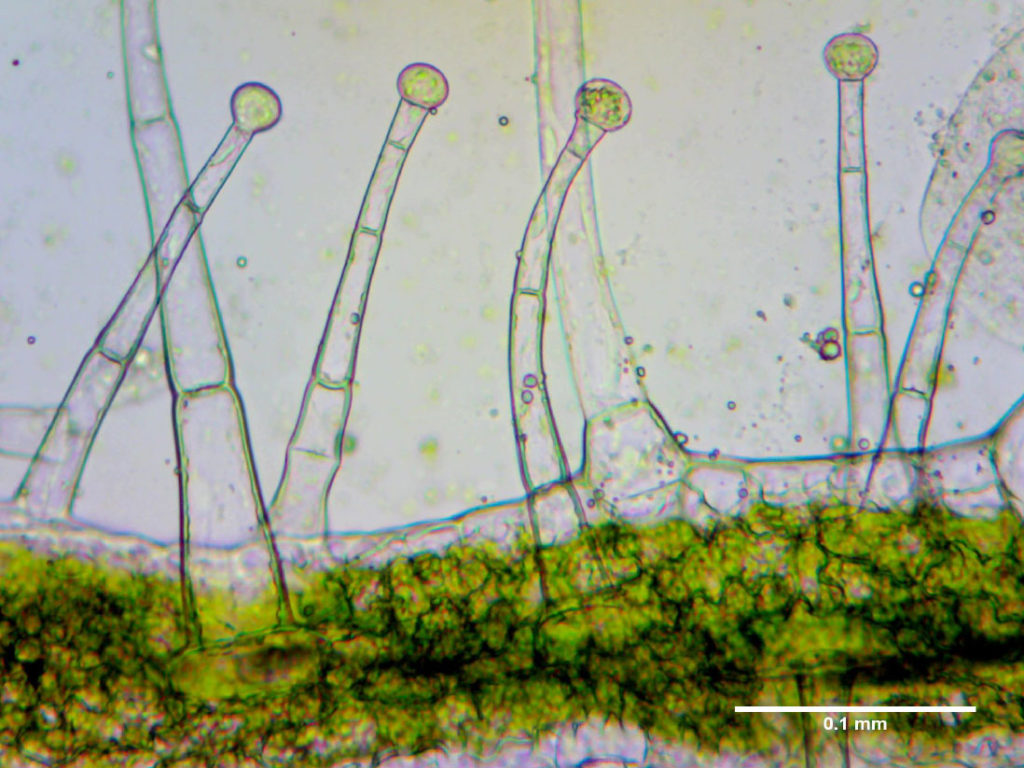
Photos by Stefan Bennewitz and Frank Syrowatka
By Ulschan Bathe
Have you ever rubbed a peppermint leaf between your fingers and wondered where the toothpaste smell comes from? It does not come from the inside of the leaf. It comes from the outside. The smell is released from tiny hairlike organs on the leaf surface that are called trichomes. (The name trichome comes from the Greek word for hair.)
Trichome Types
Although often not visible to the naked eye, trichomes are found in many plants on stems, leaves, flowers and fruits. Trichomes range in size from a tiny fraction of a centimeter to several centimeters and vary greatly in shape. They can have one or many cells and come with or without a stalk. Trichomes can be branched or unbranched, with a chemical-filled head (glandular trichomes) or without one (non-glandular trichomes). No matter what their shape is, all trichomes are specialized organs with functions important to the plant.

Photo by Kristen Van Gelder
As plants cannot run away from dangers, they have invented amazing strategies to defend themselves. For example, non-glandular trichomes form physical barriers on the leaf surface that are like dense multilayer fences. These fences are highly effective because the trichomes are long, spiked and branched. The thick non-glandular trichome fence can protect against feeding insects, pathogens, UV radiation and heat.
Some glandular trichomes have a head that produces and then secretes or stores defensive chemicals. Such glandular trichomes occur in around one-third of higher plants and are veritable metabolic factories as the chemicals they produce can make up as much as to 20% of the total leaf dry weight. Many glandular trichomes store the chemicals they produce and then release them upon contact with an insect, thereby killing the insect or trapping it on the leaf surface. Other glandular trichomes excrete salt, for instance those in mangroves that grow in seawater.
Valuable Uses
Plants with glandular trichomes are very valuable to humans. The herbs mint, basil, lavender, oregano, rosemary and thyme have been cultivated for centuries because of their trichomes, which produce and store essential oils.
Beyond the food industry, compounds produced by glandular trichomes are important pharmaceutical resources. For example, the antimalarial drug artemisinin is produced in glandular trichomes of sweet wormwood. In the fragrance industry, the sclareol made in the trichomes of clary sage is a valuable ingredient of perfumes and other products.
As researchers learn more about how trichomes work, these tiny metabolic factories are becoming new biotechnology targets for production of beneficial compounds. Progress toward this has been made by identifying molecular switches that allow production of chemicals in tomato in trichomes only. Technologies are now being developed to enable engineering the production of many valuable chemicals in trichomes, where biosynthesis and large-capacity storage come together in a single organ.
Pest Protection
Trichomes truly have superpower not only because they produce diverse beneficial compounds useful for biotechnology, but also because they can contribute to sustainability in agriculture. Common pesticides that protect crops from insect pests can harm non-pest insects, leading to many problems for agriculture and the environment.
Fortunately, though, many crops can protect themselves against harmful insects with trichomes. One example is soybean plants, which are covered by long and dense trichomes that interrupt and slow down feeding by highly damaging soybean aphids. Another example is wheat, which is protected by trichomes against various pests including cereal leaf beetle, aphids and diverse flies.
On the other side of the coin, some modern cultivars are sensitive to pest attacks because protective trichomes have been reduced or lost in the course of breeding. Potato and tomato cultivars are examples of this. In tomato, trichomes of some cultivars lack the large cavities that are present in wild relatives and store protective chemicals.
As with trichomes for biotechnology applications, current research is providing tools to engineer trichomes to protect crops sustainably against pests and thus reduce chemical pesticide use and the costs that come with it. Aphid resistance in tobacco has already been increased in this way, and many similar applications are in development.
Ulschan Bathe is a postdoctoral fellow at the University of Florida in Gainesville.









